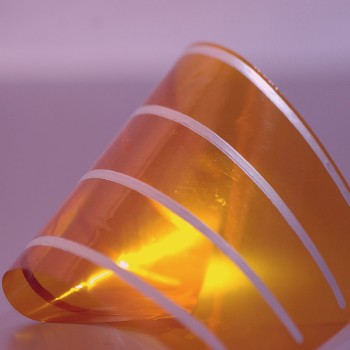Adhesives specialists Intertronics are delighted to announce availability of Polytec PU 1000, an electrically conductive polyurethane which addresses applications in die attach, bonding of components in hybrid circuit applications and surface mount technology (SMT); areas where silver filled electrically conductive adhesives have been used for many decades. Usually such adhesives are epoxy-based, two-component or premixed and frozen single-component systems, but now the Polytec PU 1000 polyurethane solution provides an alternative with many advantages, including flexibility and room temperature cure.
 Intertronics electrically conductive polyurethane adhesive
Intertronics electrically conductive polyurethane adhesive
Compared to soldering, the advantages of epoxy-based isotropic conductive adhesives (ICA´s) include lower processing temperatures, low volume resistivity, good temperature stability (withstanding reflow processes), excellent mechanical properties and chemical resistance. These advantages have made silver filled epoxies a reliable standard material for electrical interconnections in the electronics industry.
However, one significant disadvantage of epoxies is the high demand they place on the processing program. The automated application of two-part adhesives requires suitable metering and mixing equipment; single-component, premixed and frozen adhesives require a sophisticated supply chain and storage to ensure an enduring temperature of at least -40°C. Another disadvantage of both these systems is the limited processing time (pot life) after mixing or thawing of the adhesive. After application, to obtain their optimum electrical and mechanical properties, traditional epoxies should be cured at elevated temperatures (typically at 120 – 150°C).
Seeking to provide both performance and process efficiency advantages, Intertronics and manufacturers Polytec PT have introduced the PU 1000 formulation, an electrically conductive, polyurethane-based adhesive which can be considered as a very interesting alternative to epoxy-based adhesives in various applications.
Polytec PU 1000 is a single-component, silver filled, paste adhesive, which can be cured quickly at room temperature and is flexible and elastic, which makes it ideal for bonding of flex-circuits, temperature-sensitive substrates or substrates with highly dissimilar coefficients of thermal expansion. It has found applications in smart cards and RFID circuitry, where cure can be effected in seconds.
It is considered suitable for the electrical interconnection of active and passive components, particularly if convenient processing or high flexibility of the adhesive is desirable. This PU-dispersion is suggested for electrically conductive bonding and coating applications on absorbing substrates like fabric, paper, leather, cork and non-absorbing substrates like glass, ceramics, PMMA, metals and most plastics. Storage at room temperature is recommended.
For further information please see http://www.intertronics.co.uk/electrically_conductive_adhesives or visit their blog at www.adhere.uk.com – also see www.youtube.com/intertronicsadhere.